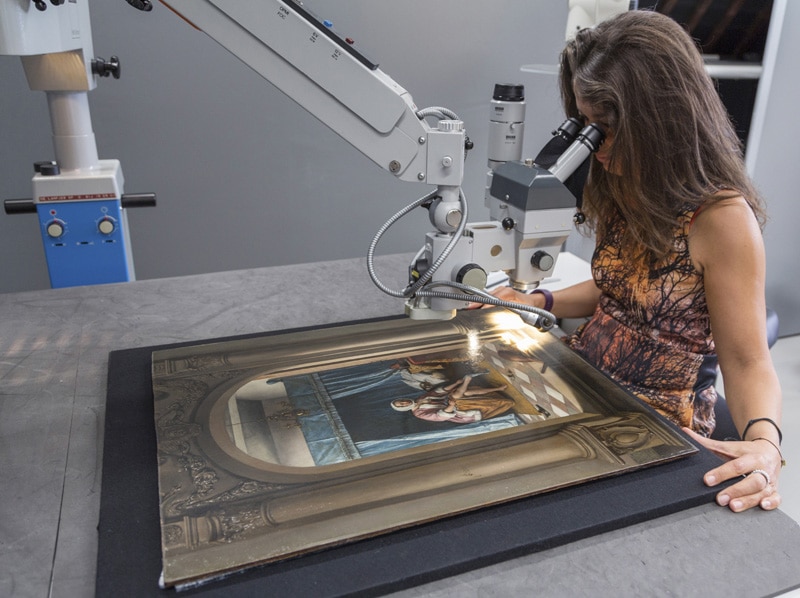Dutchmen at home is the name of the new exhibition at the Mauritshuis, which makes you scratch your head: surely the Mauritshuis always focuses on painting from the Netherlands? This time, however, it is about Dutch masters from the British Royal Collection. The choice fell on top-quality genre pieces, including famous ones such as The music lesson of Johannes Vermeer. Their temporary arrival in The Hague also contributed to ongoing research into Jan Steen's work.
Genre pieces depict scenes from everyday life, in this case everyday life in the seventeenth century. The paintings were made for residential houses, but ended up in palaces: in the gigantic collection of the British royal family. 'A match made in heaven'' Mauritshuis director Emilie Gordenker calls the exhibition: the Mauritshuis collection too once belonged to our royal house. In addition, both collections are housed in palaces (the Mauritshuis was a city palace) and some Mauritshuis pieces were once part of the Royal Collection. One of them, The young mother by Gerrit Dou, is now on display at the exhibition.
Dutch Gift
Things can get strange in the history of paintings. The Netherlands gifted the English king Charles II a large collection of paintings, including two Dutch ones, in 1660. When Dutch stadholder William III also became king of England in 1688, that collection including these Dutch Gift in his property. For his painting gallery at Het Loo palace, he brought a number of paintings to the Netherlands. Those canvases never went back.
'In turn, we jokingly call that The English Gift,' says Desmond Shawe-Taylor. As surveyor (curator) of the Royal Collection, he oversees the huge collection, which includes 7,000 paintings, 500 drawings by Leonardo Da Vinci and many arts and crafts. He also ensures that works from the collection are regularly shown in exhibitions, in and outside the UK. For the exhibition at the Mauritshuis, he was closely involved. Together with the museum, he selected the most beautiful genre pieces.
What looks like the joke is the joke
For us twenty-first-centuryers, the representations are sometimes difficult to understand. A broken pipe on the ground, a man and woman playing music together, an owl on the edge of a boat - what do all these symbols mean? We shouldn't make things too difficult for ourselves, Shawe-Taylor advises: 'What appears to be the joke in the painting, is probably also the joke.' The paintings often contain a moral, but even these he sees with a wink rather than a raised finger.

Jan Steen research
The five loaned works by Jan Steen were thoroughly examined before the start of the exhibition. The Mauritshuis has been conducting material research[hints]with the cooperation of laboratories at Shell for years[/hints]. 'There is a lot of uncertainty about Steen's oeuvre, because he only dated about one in 10 works,' says curator Ariane van Suchtelen. 'Therefore, the chronology of his work is difficult to determine.'
Fortunately, Jan Steen moved around even more often than the paintings in the Royal Collection. He lived in Delft, The Hague, Haarlem and up to three times in Leiden. That is why we are now looking for painting materials in tiny paint samples that clearly come from artisans from one of those places of residence. In one city, for example, the dye smalt mixed differently than in the others. 'In Leiden, Steen was friends with Frans van Mieris,' Van Suchtelen knows. 'Then we look at which paintings by Steen feature similar materials to those by Van Mieris from that period. We create a statistical database, in which we try to find as many patterns as possible. In this way, we hope to better place the undated paintings.'

Experimental
As often as possible, the Mauritshuis examines not only its own 15 works but also those from other collections. The Royal Collection welcomes the research on their five paintings. Shawe-Taylor: 'There's a lot of knowledge here, and we don't have the time and resources to do it ourselves.'
Van Suchtelen stresses that the research is work in progress and of an experimental nature. 'What we are doing has not been done this way before, so there is little research material to build on.' Nevertheless, there are already some nice finds to report: for instance, underlying drawings emerged here and there during the research.
Royal visit
For those for whom all this is not enough, Catherine, the Duchess of Cambridge, is coming to view the exhibition on 11 October. By the way, the collection is not entirely new to her: Catherine studied art history at the University of St Andrews.
Dutchmen in the house: Vermeer and contemporaries from the British Royal Collection, on view at the Mauritshuis. Extended until 5 February 2017
